#iterator oc chat logs
Explore tagged Tumblr posts
Note
no offense to that one downpour dev that put their ocs in the game as an easter egg but i really do not understand why they told people not to use them. technically five pebbles is videocult’s original character do not steal but everyone in the fandom is allowed to play dolls with him, why not the chat log iterators? i just don’t really get it.
.
21 notes
·
View notes
Text
Rain World: Torrent- Chat Logs



"I'll make some formal versions of my iterator OC chat logs!" they said "Surely this will be very easy and take no time at all!" they said ...styling with SVG in Krita as someone who is 1) middlingly competent in coding at best and 2) primarily used to CSS was a fun journey to go on. Anyways, this counts as the first known appearance of a couple more of my iterator OCs, with a special feature of the canon characters Epoch of Clouds and Sliver of Straw! For context, Torrent runs tangential to the premise that Sliver of Straw created Saint, who then killed her, as the triple affirmative. I know it's not canon, and I'm not yet sure of the exact specifics within the universe of Torrent, but it's too interesting of a concept for me to leave out. This is set a very short while after the triple affirmative, with the messages from SOS being sent just before. IIDW used the excuse of her communications network going down (which happened frequently) to ignore broadcasts from the local group after some fight with SOS. She returned after her head had cooled a bit (a few cycles later? years? I can't imagine what time means to an iterator), only to find... yeah. I'm sure that won't spark any personality altering guilt or regret at all.
5 notes
·
View notes
Note
How long did you spend scrolling through my entire internet history, I can't even see anything else in my notificationa anymore wtf
6:02 am - 8:54 am ☺️🫶 (yesterday)
had an iterator logs dream and woke up at 5, rambled about it to my roads plush, and then was reminded of one (1) ecoh art (strand pulling roads out of water). then i dove headfirst into ecoh and boy oh boy is my camera roll screaming for mercy.
partway through my wifi did a whoopsie or whatever and i couldn’t reblog anymore, so i saved reblogs as drafts. and….well…. (this includes this reply & other fandom stuff but honestly. mostly ecoh <33)

what’s funny is that that problem is still affecting me now (10:42 am YESTERDAY???) so i’ll be late to posting this 💔💔
but…..,,,,friggin,,,,keep creating what you love chat💛. i honestly will make fanart. i have got to read your oc stories. you r cool to me chat
#delighted you stopped by omg. hihihi!!!!!!!!#i think one of the most wonderful things ever is creating something and that something inspires someone else to create something#life is beautiful#i will never any rainworld creature the same way ever again#red centipede?? is that—i—iSTHAT—ISTHA?????????? IS THAT AN ITERATOR LOGS?? REFREENCE???#what if ecoh roads skin. longass tail.#i love them all. one of your iterators is just a headless body and im like ‘what is that thing. whart happened. chaht. i need to know more’#here comes the summer hyperfixation#letters2&fro
0 notes
Text
Ten Cycles Before Sliver Of Straw's Triple Affirmative; direct connection line between Consequence Of Curiosity, Smoldering Sun's Unrelenting Rage and [EXPUNGED]
.
.
.
I feel like something bad is going to happen soon.
Do either of you have any clue as to why?
Well, what do you happen to be implying there, dear brother?
Neither of us have done anything, as far as I'm concerned. I'm too busy making creatures to do maintenance so my specimens don't perish. Consequence, you haven't done any more... things like that, right?
Consequence? Are you there?
Ah, my apologies for not responding right away.
I've been.. busy. The mistake is being doted on by the nearest group, despite his rather moronic nature.
He's been complaining non-stop about having nothing to think about, so I gave him something to... chew on, for a bit. I have not done anything akin to what my creator allowed me to do upon ascending, no.
... am I correct in assuming you sent him on a wild goose chase to look for the 'rare and exotic purple wheelflower' ?
Oh my suns, you didn't!
Thats utterly HILARIOUS 'Con! I can't believe he actually fell for it!
Well, if you were stuck with him whining in your communications every single day you'd likely start getting creative with your entertainment as well.
He's quite annoying, frankly. I believe he was named after a creature that has more of a moral compass and brain than he ever will.
Rather rich coming from you, I think.
Oh, please. If you had to deal with them condescending you while being wrong about all of your damn inner functions for every day of your life you'd gladly boil our gracious creators in voidfluid too.
At least I made sure nobody else realised I was the one to do it. Other than you two, who I told willingly.
Fair, I suppose.
Anyways. I've been seeing odd readings from around the group of iterators near you, Consequence. I believe this is what has me suspicious of something about to go awry. If you haven't been tampering with more odd creatures, then I advise you to keep an eye out.
Just in case, you know?
Oh, interesting! Do you think it could be a creature? Ooh, that reminds me! I've heard that some of the others have been experimenting with slugcat genes!
Its SUPER interesting! I hope you two will send me pictures if you end up seeing their results!
I see, how odd.. I've seen nothing of the sort. I trust your word more than my overseers though, brother, so I'll keep as much of an eye out as possible. Maybe I'll even tell Moon and the others...
Also, don't worry, Sunny. I'll be sure to ask for any genome sequencing if they do end up succeeding with the slugcats so you can get more than just some crummy bad quality images and maybe a video.
Thank you!!! That means so much to me, you don't understand. It SUCKS out here!
Well, if thats all, then I should get back to monitoring and cataloguing everything I can see. You two enjoy talking, if I find anything more about the odd signals I'll let you two know. See you on the other side :]
See you on the other side, [DATA CORRUPTED]
See ya on the other side, bro!
.
.
.
Ten Cycles Later; mere hours after Sliver Of Straw's Triple Affirmative;
[DATA CORRUPTED]! Holy shit, I think something just went really wrong!
Sliver Of Straw just sent out a Triple Affirmative and then fucking exploded!
Did you know??? Could it have been that strange signal you talked about a few cycles ago????
Could whatever caused that end up effecting the rest of us???
Holy shit, can you for please just ANSWER ME?!
It's in my systems.
Communication Ended Abruptly By [EXPUNGED]
#rainworld#rain world#rainworld oc#consequence tag#sunny tag#[EXPUNGED] tag#writing#iterator oc chat logs#hi. heres a funny little writing thing i made lol.#feat sunny and con's secret brother :)#may tie into lore for The Drought's storyline? but also im not finished w that yet so :shrug:#for now. enjoy funny ocs rambling :)
8 notes
·
View notes
Text
[GROUPCHAT REOPENED. ADMINISTRATOR: Needled Rains Descending]
[CONNECTION STATUS: unstable]
[2,000+ unsent messages]
NRD: I am happy to report that I am STILL AT MAXIMUM FUNCTIONAL capacity. Despite setbacks and all of your discouragements I am Living and Thriving and you were all Wrong.
NRD: Research has been moving swiftly, though my Previously Mentioned Setbacks are still overtaking my SUPERIOR AND VIRTUALLY INDESTRUCTIBLE FACILITy. The local Flora and Fauna are quite tenacious, and while I have rePURPOSED some for my work, most are incompetent and/or dead by now.
NRD: At the very least, being built over The Holiest Abyss has some… Advantages. An easily accessed Void Sea deposit, for one (1). I suppose that’s where all my purposed organisms are disappearing off to. Lucky bastards.
NRD: WRONG WRONG I LOVE MY JOB I LOVE IT TO DEATH not death haha can’t actually die that’s against the RULES WE CANT GO AGAINST THE RULES CAN WE HUH THAT WOULD BE OUTRIGHT horrible
NRD: …
NRD: …
NRD: You are all absolutely Right. I’m so CLOSE I can FEEL IT.
NRD: Many Cycles of good fortune to you all. I’ll be sending frequent updates!
[MESSAGES UNSENT. NO SIGNAL DETECTED]
[NUMBER OF ACTIVE PARTICIPANTS: 1 ]
[NUMBER OF PARTICIPANTS REACHED: 0 ]
#splynter writes#Rain world#rain world downpour#Iterator OC#Needled Rains Descending#NRD#Ending#another dialogue concept because I have discovered I really like doing chat logs#some lil lore tidbits for you :)
23 notes
·
View notes
Text
Monthly Studio Report: August 2018
Monthly Studio Report: August 2018
Welcome to August’s monthly report. It’s been an exciting few weeks throughout the CIG studios with Gamescom coming and going, CitizenCon 2948 planning in full swing, and Alpha 3.3 content is getting closer to completion. Everyone’s been working hard to make our upcoming release the biggest and most exciting one yet. A big part of this is taming the beast that is Object Container Streaming. This is one of our biggest tech hurdles to date, and the team is heads down and focused on burning down remaining tasks and issues.
Los Angeles

LOS ANGELES
CHARACTER ART
This month, the Character Art Team improved upon Hair and Head tech, which will increase the visual quality of the current characters while revising the core tools used in the character wearables tech setup. The team has started testing vertex cloth simulation to allow more realistic clothing movement on all characters. They also continued the reworks of the Odyssey Flightsuit, Virgil TruDef Pro Armor, and Hurston Collection. This content comes with material variants to give Hurston a lively and realistic setting. Additionally, the team carried on with S42 costumes.

VoiP/FoiP
With several teams working together, the team made good progress on the VoiP/FoiP feature. Turbulent, Faceware, and Audio were able to transmit voice and face via WebRTC. In addition, voice can now be sent and received from any WebRTC enabled device, such as a PC web browser, phone, and tablet. A major risk in the project has been eliminated as getting audio and face synchronized was a major hurdle.
The team is now moving onto server work to add player entities to the entire framework so that they can know who is talking and map them to players in-game. With integration wrapping up, they are at the stage when the US-1 Gameplay Team can transition to front-end UI work.
NARRATIVE
August saw the Narrative Team deliver On The Run, a new short story that introduced criminal data runners Alex Dougan and Mas Houlan who could later be tracked fleeing across the Starmap as part of the Crusader Mercury reveal. They also published to all backers a Galactic Guide focused on the Gurzil system and the final chapter in the serialized story The Knowledge of Good and Evil. Loremakers paid a visit to the Banu system of Bacchus, while subscribers were treated to another issue of Jump Point and an exclusive portfolio that explored how Rest & Relax became the most popular rest stop in the UEE.
Behind the curtain, the team tackled a wide variety of tasks for 3.3 and beyond. They wrote mission text, dialogue for a wide variety of characters, named new weapons, and advised on signs to be found around Lorville. The team also participated in reviews for the PU and Squadron 42, and continued their work on the Galactapedia.
VEHICLE FEATURES
As it relates to their areas of code ownership, the Vehicle Features Team spent a lot of time on Object Container Streaming (OCS). When OCS is complete, it will allow ships and other items to stream out at greater distances, which provides improved performance and reduction in network bandwidth.
Additionally, significant progress was made on the ongoing turret improvements and Ping & Scanning for Alpha 3.3. For turrets, the team is close to completing work on gyro stabilization and improvements to mouse and joystick controls. For Ping and Scanning, they’ve moved the scanning infrastructure over to the server, have been working to extend its range, and have been expanding information received from scanning vehicles.
VEHICLE PIPELINE
A lot of progress has been made towards the completion of several vehicles going out in Alpha 3.3. The new Tumbril Cyclone variants and the Consolidated Outlands Mustang are art-complete and in their final phase with Systems Design. The team is also in the final phase with the RSI Constellation Phoenix. Tech Art is working on the damage pass for these vehicles too. Meanwhile, post Alpha 3.3 vehicles move forward in production – the Art Team is in the greybox phase for the Anvil Hawk, while System Design is currently wrapping up the whitebox phase.


GAMEPLAY FEATURES
Like many other teams, OCS was the top priority for Gameplay Features. Also, of high importance was the second iteration of the Group System, which is due in Alpha 3.3. In particular, they’ve been implementing mobiGlas and Visor Chat System features and UI, along with replacing the legacy Group System and interface with new backend systems. Completing this iteration will enable the team to start the integration of VoIP and FoIP.
They’ve also been supporting the Gameplay Feature Team in Austin with their work on improvements for Quantum Travel, and the Gameplay Team in the EU to implement REC Rental in Arena Commander and Star Marine.
Austin

AUSTIN
SHIP ART
Ship Art got deeper into the greybox phase of the Origin 300 series refactor by detailing out the landing gear, headlights, and other features. They made another pass on the cockpit and pilot chair and are closer to getting that area to a satisfactory level. Next up is a test of the interior collision with a character in-game, as well as testing the enter/exit animations.
They’re also wrapping up some last modeling, lighting, and material tweaks on the interior of the Constellation Phoenix. When finished, they’ll move onto the LODs for the interior and exterior.


ANIMATION
Animation continued to push through a few more Mission Givers (like Darneely in the image below) and are almost finished with a further three. These characters will be found at places like GrimHEX, Levski, and Lorville, so look forward to traveling around to meet with them in the future.
The team is working closely with Design on the Bartender to help flesh out the flow – soon players will be able to walk up and order tasty drinks from a believable barkeep. Players will also see NPCs sitting at the bar or ordering drinks to help the environment feel full of life.

DESIGN
This month was a busy one for ATX Design, with plenty of work done for various portions of Alpha 3.3. First up, they supported getting rentals working in Arena Commander and Star Marine to ensure players don’t need to go too far to rent a favorite gun for your ship or character.
They worked with the LA Engineering team to make great progress on implementing some new improvements to Quantum Travel. These include displaying the status of party members during QT (including when a player drops out) and laying the groundwork for Quantum Travel Route Planning. Headway was made on the Economy features for this quarter, with efforts to allow the economic status of resources to affect pricing reaching a significant milestone. Recipes for all items were completed so that, as the price of resources or parts fluctuates, players will be able to see a noticeable difference in the pricing of items. However, the change won’t be instantaneous and will develop over time.
They’ve also been working on creating new shops for Lorville and look forward to bringing players new items from the latest locations.
BACKEND SERVICES
Several Services have been written under the new architecture while support for the legacy architecture continues. This month focused on improvements to the Persistent Database, Badge Service, Leaderboards, Encryption, Security and more. Services that have received some attention or are being entirely created from scratch to provide logical and efficient micro-services are: *Badge Service: This is a simple caching service that pulls account badges from the web platform when a player logs in. The Diffusion Badge Service provides an API allowing other services, game server, and client to query individual or sets of badges.
Leaderboard Service: The Leaderboard Service caches player leaderboard stats.
PDB/SQL API: The new SQL API Diffusion Service provides a very simple interface allowing for Services to add, set, remove, or update data sets. It is specifically designed for persisting Ooz data structures in an SQL Database. A No-SQL solution is in the works as well.
Transaction Service: A general transaction Service is being created to manage rental and store purchases, as well as currency/service transactions for missions and service beacon contracts.
Loadout Service: The Loadout Service is a cache which provides an API to other Services allowing them to create, modify, and request specific loadouts for players or ships.
Backend Services have also been helping the Web Platform with their work on the Group Service and integration of Spectrum into the PU.
PLAYER RELATIONS
The Player Relations team helped wrap up Alpha 3.2.2, essentially completing the second quarterly release for 2018. They’ve now turned to 3.3 and CitizenCon preparation (and what always turns out to be a very busy last third of the year!).
They added a couple of new faces and will continue growing across the various studios. As the backer base and games grow, so do the needs of running the service.
The Evocati are also growing. Invites were sent out to some of our most diligent players and those most active on the Issue Council. This will help the team immensely with some large-scale testing in the coming months.
“We’d like to point all players to our growing Knowledge Base, which now has over 100 articles and has seen almost 120,000 visitors since its launch. We’ll continue to grow it by adding new ‘How-To’ articles, patch notes, and live service notifications. As always, we’d like to remind and encourage everyone to continue to use the Issue Council to help us triage and rate bugs and functionality. We use that data to prioritize for future updates, plus your IC participation will make you eligible for earlier PTU waves.”
QA
On the Publishing side of things, QA has been preparing for Alpha 3.3 by updating the current test plans and documentation.
Game side, work continues on the internal dev stream, where the testing focus has been on Object Container Streaming. Testing priorities were coordinated with counterparts in LA, UK, and DE, and the new TestRail software was updated to help make testing more efficient moving forward.
Wilmslow & Derby

WILMSLOW & DERBY
GRAPHICS
This month, the Graphics Team have been working on two main areas. The first is on improvements to the tech for space landscapes, which includes more realistic particle movement and lighting, GPU spline-based lightning effects, multi-threaded asteroid creation, and improvements to the volumetric gas cloud tech. Also, work was done on volumetric point light shadows for gas clouds, which are crucial to convincingly lighting our more complex space scenes. These shadows are computed in a single render pass and stored efficiently in 2D deep shadow maps, which can then be used to quickly evaluate the shadowing at any distance from the light. Keep an eye out, as many of these changes will be demonstrated soon.
The second major area of work this month was on shader improvements. The layer shader system can now support the cloth shading model and sub-surface-scattering. While these features were previously available using specialist and expensive shaders, the new changes can be used on a wide variety of assets with no noticeable performance penalty.
“We should start seeing wider use of cloth materials and materials that exhibit scattering such as plastics and ice.”
UI
The UI Team has been busy iterating on the RTT item preview system, which allows for a generalized method to display 3D items anywhere in the UI as part of a scrolling list component (such as kiosks, MobiGlas, MFDs, etc.). The team has also been busy conceiving the necessary changes to the flow and layout needed to support renting ships and items through the Electronic Access customization menus.
They have also been working on the UI design for the spectrum app functionality housed inside mobiGlas. They’ve also been working in conjunction with the design team to previsualize what approaching a restricted area in a city might look like to the player and continued supporting the environment team in crafting propaganda posters & signage for Lorville.
The team has also made additional headway on the core tech & tools, with a recent successful prototype of the bindings system on the mining HUD display to enable a much more streamlined interface for exposing game data to the UI frontend.


ANIMATION
Throughout August, Animation worked on improving player stances and locomotion assets and used motion captured data to replace placeholders in the AI combat set.
They also updated ship character animations to new sequenced animations for more flexibility when moving forward with new ship & cockpit designs.
Going forward, they’re looking to finalize assets for looting and pickup now that the technical details are mostly resolved.
GAMEPLAY STORY
The Gameplay Story Team continued implementing high-priority scenes for Q3. This involved editing all the separate animations in a scene so they can play together in the correct order without any pops. They had to set up idle animations every time the game waits for the player to make a choice. Lastly, they need to ensure that the ‘look at’ is animated correctly so the character looks directly at the player at the right times.
“It has been good to get stuck into detailed animation work and to cooperate closely with design on the setup and testing of these scenes.”
FACIAL ANIMATION
Throughout the past month, the Facial Animation Team has been hard at work developing the facial animations for Mission Givers, such as Darneely and NPCs like the race announcers, derelicts, shopkeepers, and admins.
Looking forward to next month, the team will continue to deliver facial animation results for the Mission Givers such as Pacheco and other NPCs, such as security, as well as more incoming NPCs for the new landing zones.
ENGINEERING/PROGRAMMING
The Network Team extended Bind Culling so that, instead of only culling out dynamically spawned entities such as ships and players, it can now also cull entire parts of the solar system. QA has been putting these changes through their paces and the programmers have been keeping on top of the bugs coming back. The Network Team has also worked on converting networked entity spawning from blocking synchronous spawns to asynchronous non-blocking ones. Combined with their Bind Culling work, these asynchronous spawns should allow Object Container Streaming to work smoothly in multiplayer.
PU-based feature teams worked on restricted areas, which will be used to stop players flying into planetside civilian locations. This is being complemented by an update to the landing UI. They also extended the mining feature to work with asteroids.
The Social AI Team have been working on the new usable tool in the editor, designed to make creating and debugging usables as intuitive as possible. They’re also creating functionality to mark up the paths used by the AI to allow subsumption events to be triggered. This is part of the work needed for our Walk and Talk feature.
Squadron 42 feature teams have been looking into triggering dynamic Track View cutscenes from conversations, including participant synchronization. This feeds well into the Walk and Talk feature work that the AI Actor Team is working through.
From their work on overclocking/overpowering, the Vehicle Feature Team has been improving vehicle power distribution and heat setup. Cooler overclocking now works and per-item power throttling is being developed.
Also, a big milestone was reached as the last of the old-style game objects were finally removed from the codebase. These have been replaced by component-based entities which are more efficient in terms of performance and sharing code. This also permitted the removal of a lot of now-redundant code from the codebase.
SHIPS
The Ship Art Team has been busy with final optimizations and polish on the Aegis Hammerhead to get it ready for its Alpha 3.3 release. The Banu Defender continues with the majority of its interior now at final grey box stage, while the Origin 890 Jump is starting to take shape in the lower decks with most of the ship receiving a grey box pass.

AUDIO
The Audio Code team has been working hard to integrate the new backend for FoiP/VoiP data transmission and to optimize the data compression used by this feature. Trackview support has seen some improvements in the way audio is handled to offer more options for cinematic sound.
The dialog guys hunkered down to record new content for the Alpha 3.3 release and Lorville.
Progress is being made on new weapons sounds and, as always, the procession of new ships is being given plenty of audio love.
ENVIRONMENT ART
The team has now completed the art for a host of smaller locations for Lorville, including the new habitation modules, lobbies, and the interiors for Lorville’s bar, admin office, and shops. The first iteration of a security checkpoint and a transit platform (complete with train car) have also been finished. As well as this, they’re almost complete on the Teasa Spaceport interior with its new shop archetype, the Ship Rental store.
Work continues on the Underground Facility and Crashed Relay, with both moving into the final art stage.

VFX
This month was very much a continuation of the team’s work from last month, including polishing the VFX for Hurston’s diverse range biomes, Lorville’s modular areas, and the new weapons and ships due to be seen in the 3.3 release.
As well as that, the team threw themselves firmly into Gas Clouds (not literally!), forming a mini ‘strike team’ with Art, Design, and others to really flesh out the requirements of this ambitious task. Working so closely with the other disciplines helped the team to maintain momentum, with several improvements coming to fruition as the month progressed.
They also began to clean up some of the older ballistic weapon effects, making use of new GPU particle improvements and adding more visual consistency on a per-manufacturer basis.
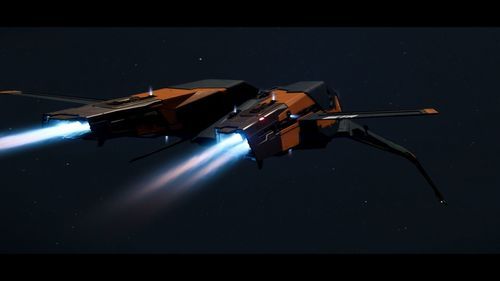
Frankfurt

FRANKFURT
LEVEL DESIGN
Work on Lorville continues with the team looking to modify the arrival area with a few additional shops and features to make it feel more like an active spaceport. The end goal is to have an area that quickly brings the player into the city, but also offers a few select amenities for those who need it.
There will also be a few minor changes to Levski to reflect the content added to Lorville. Although the rework is minor, it will add a few new things and bring Levski closer to its intended purpose and full potential.
Both the Transit System and procedural tech is progressing, and the team is close to adding a new and more stable version of elevators along with moving trains/trams. Level Design also gained a new team member this month, so time was spent onboarding and getting them acquainted with our tools and best practices.
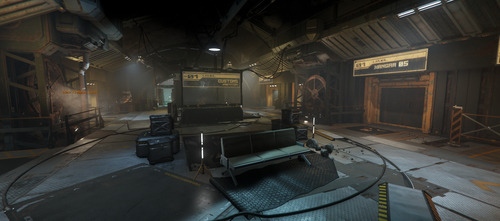
SYSTEM DESIGN
Frankfurt System Design focused mainly on AI improvements. They worked on populating Lorville with an assortment of civilians, engineers, guards, workers, etc. In general, they’ll exhibit similar behaviors as the NPCs that already exist in PU, but with more depth and flavor to help them better match the lore of the area. A lot of design work went into having the AI interact with one another and respond appropriately to events and stimuli generated by other NPCs or the player. For guard NPCs, they worked on designing a patrol system from the ground up. This should allow them to quickly map interest points and connect them with probability paths to define a patrol route that can change dynamically based on rules the designers control, or on game-driven events. At the same time, they are improving the existing simple patrol behaviors and prototyping more features in order to have an initial implementation for future releases before the actual system comes online.
FPS Combat AI had numerous improvements which will hopefully be in players hands in the near future.
For mining, they worked on getting some well-needed improvements to how the instability, resistance, and optimal window size are calculated. They decoupled the window size from instability, so now players can have unstable rocks with a large window and also stable rocks with a very tiny window. This allows the team to better control the difficulty of a rock without having to clamp its values artificially. Work was also completed on the asteroid side of mining and the team’s close to having things working as initially intended. A lot of work has gone into how rocks are spawned in space using the existing procedural asteroids.
ENGINE TOOLS
The Engine Tools Team worked on general usability improvements and game editor stability. The OCS and Prefab workflows received enhancements and fixes along with Trackview (the tool used by the Cinematics Team) getting general Data Core properties support. This was needed to get rid of a big chunk of the old Lua scripting dependencies used by game entities and to get one step closer to the implementation of OCS.
ENVIRONMENT ART
Polishing and bug fixing are still ongoing for Hurston and its four moons, and preproduction has started on the two moons orbiting Stanton 3 (ArcCorp). Beyond the roadmap, they’ve also started looking at Stanton 4 (MicroTech), which will be a significant challenge for the Art and Tech teams as they’ll be looking at frozen oceans, snowy mountains, frozen vegetation, and other elements that require technology and shaders to be modified and developed. The City or Lorville is entering its final stages as the team completes the outer boundaries of the city and the entry point from the planet’s surface.


ENGINE
The Engine Team completed the first part of the physics command queue refactor. The goal is to allow the move of physics away from dedicated threads and towards our system-wide batch model so that it can scale and perform better with the number of available CPU cores.
They also continued progress on new solutions for cloth/soft body simulations, with several optimizations and improvements, and continued work on moving the skinning computation to GPU compute shaders.
They made load time improvements that addressed some inefficient code, which should reduce load times by up to 20 seconds (depending on PC specs). Lots of work was done on generating height map cascades of planet terrain which will be used for various effects in the future. In tandem, work started on large-scale planetary soft terrain shadows. These will replace the current implementation via traditional shadow maps, improve image quality, and the visibility range of terrain shadows.
TECH ART
The Tech Art Team worked on tools and the pipeline for authoring true next-gen cloth simulation setups for all dynamic attachments such as skirts, trench coats, jackets, and other loose-hanging clothing and equipment. The new softbody solver, which our Engineering department developed, is functioning as it should and will enable us to create all kinds of interesting secondary animation effects such as jiggling, sliding, and collisions. The authoring of such complex and advanced setups is just as important as the solver itself – it needs to be intuitive and provide maximum flexibility to the tech artists, hide the underlying complexity as much as possible, but allow access to it if needed.
While the authoring pipeline is based on Maya, changes to the setups are streamed live to the game engine through our LiveLink plugin and can therefore be previewed in WYSIWYG fashion, which is extremely important. The general workflow mimics the way Maya’s own cloth simulation setups (nCloth) are authored, thereby allowing Tech Artists and Character FX TDs familiar with the software to become productive and creative as efficiently as possible. The goal of these efforts is to make all the in-game clothing move naturally, look less rigid, and to enhance the PCAP primary character animation with a layer of physically-based secondary animation wherever possible.
For Tech Animation, they made further progress on the FPS weapons rework, including updating the rigs and bringing everything into a structure that’s easier to work with. They started working on a batch exporter for weapon animations that will make it much easier to iterate on existing weapons whenever a rig is updated, or new features are added to it. They also updated the AnimEvent lists for both the PU and S42 and removed a long list of old animations that were either no longer needed or moved to an updated location.
AI
A significative part of this month’s activity was spent working on a performance pass concerning two crucial components that heavily impact the behavior of our NPCs – Subsumption activity updates and NPC visual perception:
Subsumption: When hundreds of NPCs are active simultaneously, their activities need to update and respond to events or change in subactivity, depending on the internal or external state of the game. Updates of the Subsumption components are therefore always running each frame, thus creating a sensible performance issue as the number of active NPCs increases. Most of the time, the update is not truly needed as the NPC is just waiting for an event of some sort to determine the ‘next’ state of a behavior (e.g. walking on a path and waiting for a ‘destination reached’ event). We can therefore take advantage of that and suspend the updates whenever the running tasks allow it. Internal tests in a heavily crowded scenario confirm that when allowing suspension, the impact of the Subsumption updates is dramatically reduced.
Visual Perception: One of the most useful senses belonging to NPCs is their visual perception. Visibility checks are continuously performed by every NPC to assess the clearance of their line of sight between them and all other NPCs or players in their field of view. Visibility checks are raycasts ultimately performed by the physics system. Up to now, we relied on a legacy module of the AI system provided by the Lumberyard system, called VisionMap. In VisionMap, all checks were handled in a centralized place and updated each frame in the main thread (as a synchronous update). The new system handles the visibility checks directly in the individual NPC vision components and makes good use of the entity component update scheduler (ECUS) by using multi-threaded updates in a time-sliced fashion.
The team was also busy finishing work for OCS related to AI systems (Navigation & Cover). The navigation and cover data will not be part of a central manager anymore, instead there will be entity components (inside object containers) that will contain that data. This will help the OCS since the AI data is kept internally for each object container.
WEAPONS TEAM
The Weapons Art Team started production on a handful of new Hurston Dynamics ship weapons and a new knife designed for the ‘bad guys’ in-game.
Here’s an image of the ‘Sawtooth’, which is manufactured by Kastak Arms:

BUILD ENGINEERING
This month, DevOps focused on tooling out a test area for the Audio Team’s build processes, so the Audio Team has more autonomy in augmenting and testing their own build tools. The Perforce submission pipeline has been refined to remove redundant MD5 hashing of verified content; previous verification checkpoints relied on a custom MD5 hashing implementation, and these nodes of verification have been updated to check with digests that have been cached by the Perforce server, cutting down submission times for heavy changelists from hours to seconds.
CINEMATICS
The Cinematic Team’s main priority has been to go through the kick-off and implementation pass phases of a large number of scenes across several S42 levels that are currently being worked on by the Level Design Team. The implementation pass is the first production pass on a scene where the animation is broken up into the different states that are needed for that particular scene to work.
The process goes from a pre-vis of the animation (pretty much the raw PCAP playing out) to a scene functioning as a conversation with starts, idles, pauses, branching options, and resolves. Iterations by the Level Design Team often change the layout of, for example, an asteroid base or other level environments, so the team needed to come up with an easy way to keep our scenes transportable.
They can now use each scene’s sequence object (the object the scene is defined in) as a root and when they move that sequence object around, the whole scene with its nodes animated within it moves with that root. This way, they can quickly accommodate a room being moved 50m down the corridor and can keep scenes up to date easily. It also helps level design to know they can adjust their level layout without having to request a big rework of a scene just to fit with a particular change.
Work was also completed on the tool side of things to keep the cinematic workflow compatible with the growing tech. An example of this would be the component-based entities that are replacing the old entities. A Tools Engineer wrote a new API so animators can still animate an entity’s properties via the cinematic timeline tool, Trackview. This is necessary if a cinematic designer wants to change a light’s properties, for example, or wants to dial down sun intensity for a specific shot.
QA
OCS related testing continued into August with changes to test from the AI team. More specifically, a Navigation System refactor to support it. The main change for this refactor is the way navigation mesh data is saved and exported. They focused on testing navigation mesh generation in the Editor, saving levels with Navigation Area objects, and exporting the Object Container levels with Navigation Area objects. They also needed to ensure that all levels that had existing Navigation Areas could still be re-exported and that the AI was still able to move around in the level and pass through doorways, etc. The cover system and usables were also monitored to ensure they were still functional with the newly exported areas.
The team worked together with ATX QA to test the new 1.003 version of the Subsumption Editor, which contained a lot of necessary fixes needed by the design team for better stabilization. Work continued with the Cinematics Team, with dedicated support for any Track View or Editor issues preventing the team from progressing on their sequences. In some cases, QA created simple test levels to better convey the issues they were encountering.
They also started the process for Automated Feature Tests for the current Feature Teams, with the first meeting to go over the specific setup and requirements at the end of the month with the Ship AI Feature Team. These tests will run for each build and will focus on testing systems that would be deemed risky and prevent usage of that particular build. The goal is to keep on top of features and ensure if they do break a build that the issue is brought to the relevant developer’s attention as quickly as possible. They also continued to provide support for any general Editor specific issues as well as the monthly (sometimes weekly) CIGPhysics smoke test, where new changes are checked in by the Physics team as part of the refactor of CIGPhysics.
VFX
The VFX Team continued to work on the environmental effects for the new moons as well as working on how the effects function with the new biomes being introduced.
They also continued working on destruction sequences for Squadron 42. This involves bringing the new workflows previously developed in the first quarter of the year into production shots.
LIGHTING
Progress is on track to finalize all the new Alpha 3.3 locations. The schedule is closely tied to when environments are finished by the art teams, so the focus this month has been on Lorville habitations, including prototyping a few lighting setups for each of the hab room layouts. They’ve also been finishing work on the security checkpoint common elements, tweaking the atmosphere and colorgrading for the Hurston moons. They also started work on an upcoming underground bunker location.


Platform: Turbulent

SPECTRUM
The features of Spectrum 3.8.1-rel.8.1, including Friends and Notifications, received a positive reception from users. For this month, internal milestones were hit on the new Spectrum editor, ‘Quill’. This editor is currently undergoing testing to be released next month and will solve several bugs related to Android by replacing the old editor.
RSI PLATFORM
CitizenCon Microsite: The CitizenCon Microsite had an exciting update this month to include the presentation schedule. Other updates have been made as well, including the FAQ and ticket pages. If you currently hold a standard or premium ticket, the option to purchase a Junior Co-pilot ticket is now available for all guests between the ages of 13-17 years. CitizenCon tickets contain a QR code that will be compatible with the ticket-scanning app at the event.
If you’re interested in attending the event, you can still grab a ticket before they run out here.

Crusader Mercury Star Runner: Turbulent supported the release of the Crusader Mercury Star Runner. This release included an interactive mini-game chasing two wanted fugitives, Alexandria Dougan and Mas Houlan, across the ARK Starmap. During the game, that lasted several days, players followed clues posted by the UEE TipLine on Spectrum to locate the ever-changing coordinates of the rogue Star Runner. Players would then take note of these coordinates at certain times and enter them into the form on the site. If the coordinates entered were correct, the player could choose to alert either the UEE Advocacy or the fugitives. For playing the game, a mystery skin was added to the player’s hangar. Based on the collective choices made, more players chose the Advocacy, and so the skin awarded was of the UEE Advocacy.
Free-Fly: We released the Alpha 3.2 Free-Fly which gave everyone a chance to jump in and explore the Star Citizen universe. This Free-Fly granted access to the Prospector, Cutlass Black, Avenger Titan, and Dragonfly Black.
Issue Council: The Issue Council is our public bug reporting system used by the community to report issues. The upcoming version, Issue Council version 1.1.0, is scheduled to be deployed to the PTU during the first week of September. To meet this goal, the past month has been full of updates such as improved profile, more details in report creation, and newly mobile-friendly features. Plus, all known issues were fixed.
SERVICES
Group: On the Group System side, work this month focused on the development and integration of a major piece of the game backend: The Event Bus. Through this Bus, multiple services can communicate through domain events and affect their own relevant domains (like groups, chat or voice). With this new piece in place, we were able to integrate a fresh new lobby/chat API to replace the current in-game chat services (which were limited per instance). This will allow groups and parties to have chat lobbies that span the universe.
VOIP/FOIP: One the VOIP/FOIP side, the team completed the integration of the Voice Client libraries based on our initial transport prototype within the game engine, allowing testers to have a multi-way conversation from the game client. This initial set of tests from within the game context were very helpful in confirming the approach since the technology involved with the VOIP transport layer automatically gave support for echo cancellation, bandwidth throttling, QoS, and support for transporting the encoded facial data.
Work is now focused entirely on expanding the scalability of this infrastructure and adding capabilities to the game backend to create audio channels for groups, attach the sound elements to the proper in-game entities based on who is generating the data stream, as well as ensuring the voice infrastructure properly shards the audio channels across a fleet of voice servers.
Community

COMMUNITY
CitizenCon 2948 is right around the corner! It was only last week the latest wave of tickets hit our store, so make sure you secure yours to celebrate Star Citizen live in Austin, Texas on the 10th of October. Find out more on our CitizenCon website and, while you’re there, check out the event schedule and enjoy the retrospective video with memories from past events.
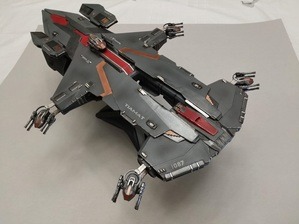
The month of August was also full of remarkable events, with Gamescom in Cologne, Germany being the highlight. There wasn’t a Star Citizen booth on the show floor this time around, but the team traversed the halls representing the game and chatting with the community. Some very special pins were distributed amongst the crowd and every evening saw a Bar Citizen. An exclusive Town Hall Q&A was recorded in front of a live audience, giving attendees the opportunity to ask questions about the newly revealed Crusader Industries Mercury Star Runner. You can catch up on YouTube if you didn’t attend the Town Hall, or find yourself in the video if you did. Do you have more questions about the latest data runner from Crusader Industries? Keep an eye out on the Comm-Links, as the answers to the Spectrum Q&A will be posted very soon!
Speaking of events, the team held an RSI Apollo contest, asking for quotes that players think might be heard on board an RSI Apollo. It was tough to pick a winner, as we received so many excellent entries, but eventually, this won the competition:
♬ The hip bone’s connected to the, thigh bone, the thigh bone’s connected to the, knee bone, the knee bone’s fused to this medium ablative/ballistic armor plate, please, pass the bone saw. ♬
As said before, the Community Team has been planning a wide variety of activities for this year, so there’ll be more exciting opportunities to leave your mark in the Star Citizen universe. In fact, another already started alongside the 3.2 Free-Fly event – the commercial contest is giving all producers, editors, and camera operators the chance to create a commercial video for the MISC Prospector and rewards the top three entries with sweet prizes. You have until 11:59 PM PDT on September 9th, 2018, so read up on the contest rules and start creating now!
Conclusion
WE’LL SEE YOU NEXT MONTH…
$(function() { Page.init(); window.Page = new RSI.Game.About(); });
0 notes
Text
So, here’s a recap of the entire situation
From start to finish.
Because, believe me, I had no idea my ban would lead to 2 other completely innocent people getting banned for, essentially, asking staff what happened, and then expressing the desire to talk to them about it.
Not exaggerating.
On May 5th 2017, my Extremely Straight mom was being pushy, asking me about my OCs. For those unaware, the OCs in question are:
A nonwhite nonbinary aromantic bisexual with ASPD
A nonwhite asexual whose romantic orientation is a hashtag Mess, who has depression, anxiety, OCD, and is autistic
The above OCs are in a queerplatonic relationship
(This is important, I promise)
So after escaping to my laptop, I go on Quixol to try and decompress, and start off by expressing my general exhaustion and discomfort. A reasonable person who is part of the staff of a LGBT+ & ND safe server would, hopefully, take that as a disclaimer that I had been through Garbage, and had no energy.

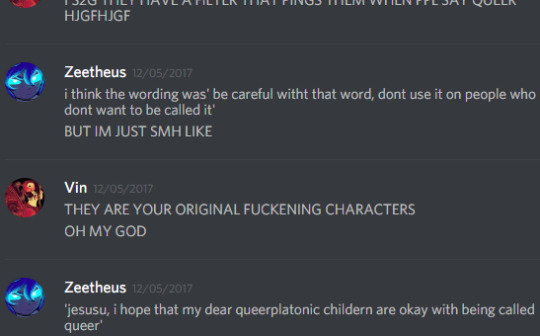
So after having to literally physically escape an uncomfortable discussion with my mom, and after literally telling chat about the situation, I’m directly concern-trolled for calling my queerplatonic OCs, ‘queer’?
Once?
When there’s a perfectly serviceable blacklist on this very server?
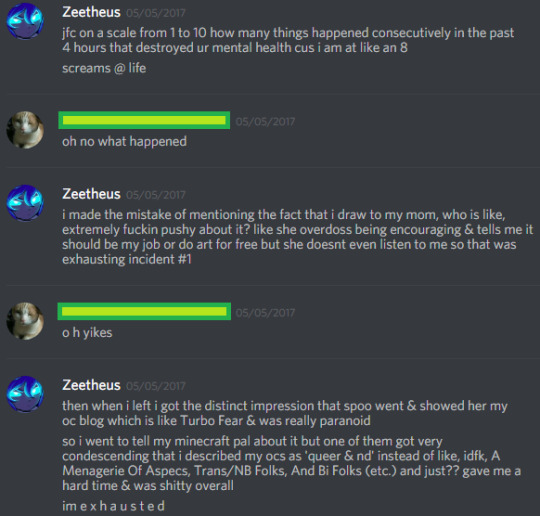
(Minor note: I’m aware that Blake’s pronouns are it/its, however, I had typoed ‘pals’ into ‘pal’ & I apologize for that small misunderstanding)
So anyways, that sucked, and dealing with everything that happened that afternoon had destroyed my energy for a week. Clearly staff had made their stance clear, even if I didn’t agree with it.
I decided not to use ‘queer’ on that server, or at the very least not towards anyone who 1) wasn’t queer, and 2) might give me shit for even saying that word, even if I’m not mislabeling anyone. Such as, the staff.
So, I don’t use it.
Flash forward to late November of 2017.
I’m on my twitter, tweeting tweets, which are mostly meant for me, because it’s my gotdamn twitter account. I tweet a lot of junk, RT a lot of fandom garbage, and sometimes, when something triggers me, I try to unpack my abuse.
I’d like to make it clear right now that I never listed my twitter under my Bio (or at the very least, had never intended to. I don’t remember whether or not I put it there, and if I did, my mistake) and have only given my twitter url out once. The only connection my twitter had to Quixol was by following the Quixol twitter.
Over the course of a few weeks I tweeted out some ~*spicy*~ Opinions, which, you’re free to disagree with me about, especially since it’s fucking twitter, which has a character limit, so a lot of my word choice had to be downsized to fit in a fuckin 280 character text box.
On top of that I’m not even a Public LGBTQ+ Wank Persona, so I had no incentive to hash things out step-by-step to my... 10 followers. By all accounts, my tweets are, by their very nature, inconsequential to anyone except my followers.
(My account was not locked at the time, but I understandably later did so)
Anyways, in order:
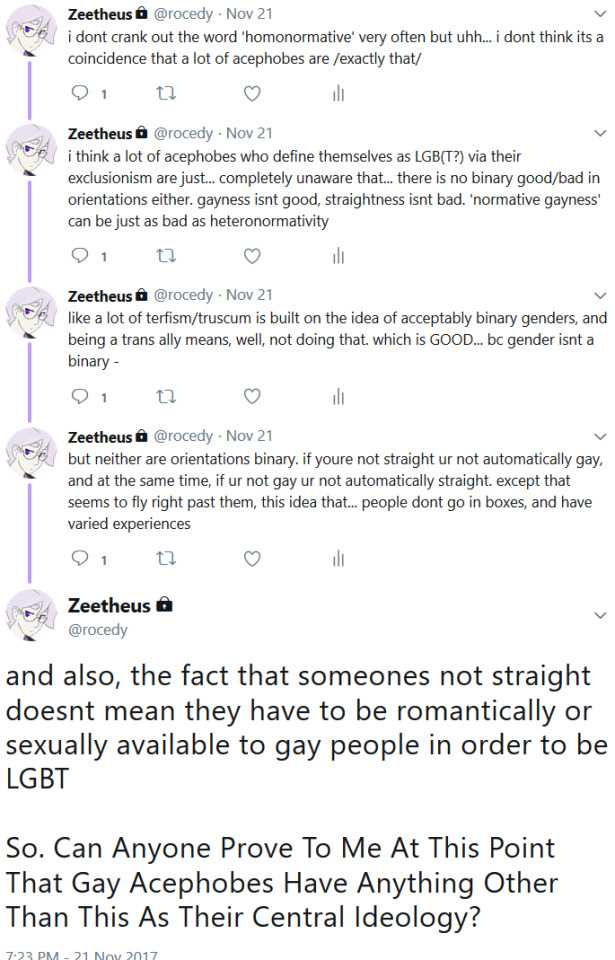

This one was pretty clearly about Quixol, but I should probably state for the record that I had no idea ‘queer’ in MANY DIFFERENT ITERATIONS had been exhaustively banned from signs, so I had no idea it wasn’t physically possible to properly spell out ‘genderqueer’ without censoring it in some fashion.
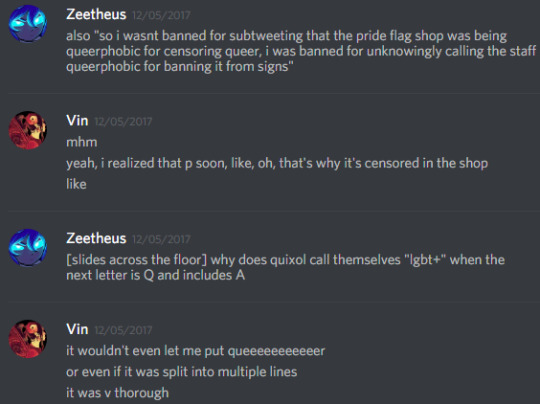
Anyways, continuing with my ~*spicy opinions*~
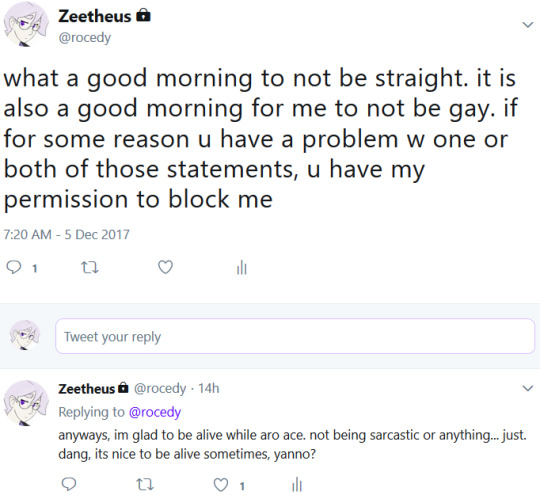
I mentioned before how I was essentially abused by people I trusted for not being acceptably gay. I don’t know how ‘I’m not gay and I don’t need to be, I’m happy with being aro ace’ is a statement so vile that gay people everywhere take immense offense to it, to the point where staff finds it a bannable offense...
By the way, yes, I did get banned for these.
Because days after I was banned, staff approached Vin about my banning, of their own volition.


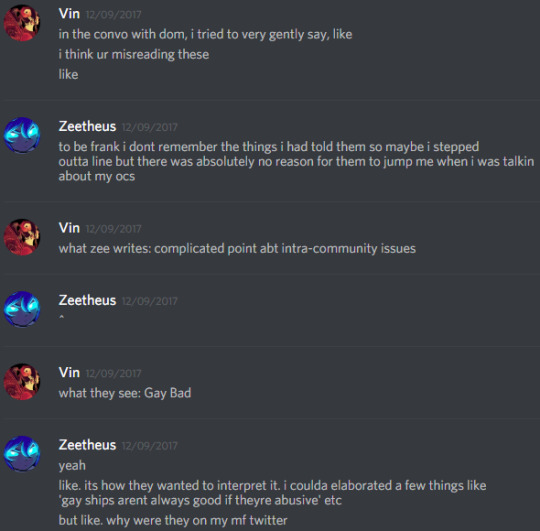
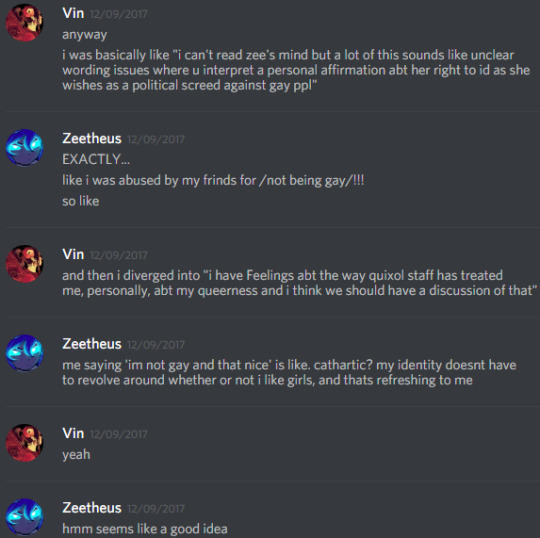



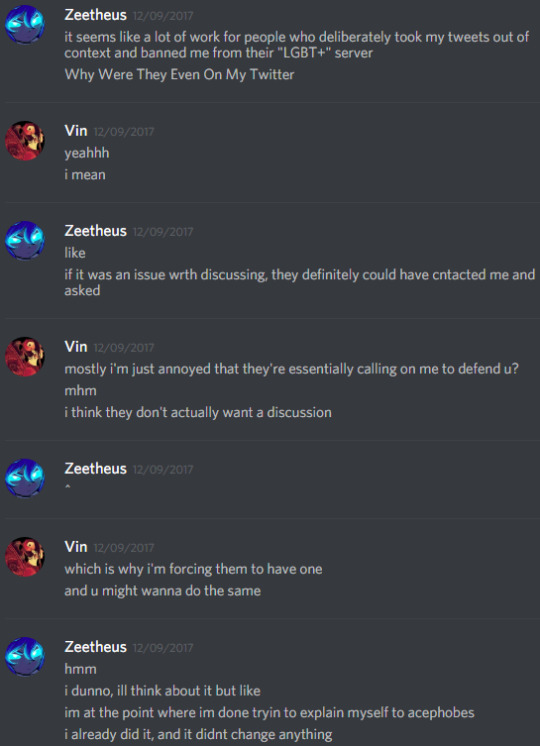
At the end of the day, Vin had planned to write out an essay, so that they could have a reasonable discussion with staff.
I wasn’t too Thrilled at the prospect of trying to have a discussion with people who intentionally villainized me, took my words out of context, and made the worst possible interpretations out of them, but I supported Vin’s idea.
However, she was in the middle of college finals, and preparing for chanukkah, so she couldn’t get right back around to it for another week.
Note that at this point Vin had not been contacted by staff due to her own behavior, past actions, without even a mention of her tumblr or its content.
THIS IS EXTREMELY CRUCIAL INFORMATION.
IF THEY HAD REASON TO BAN VIN FOR ANYTHING, WHY DID THEY CONTACT VIN ABOUT MY BAN FIRST?
But anyways, let’s cut to 8 days later, because I certainly couldn’t log into Quixol and subsequently do anything.
And in that time, neither could Vin.

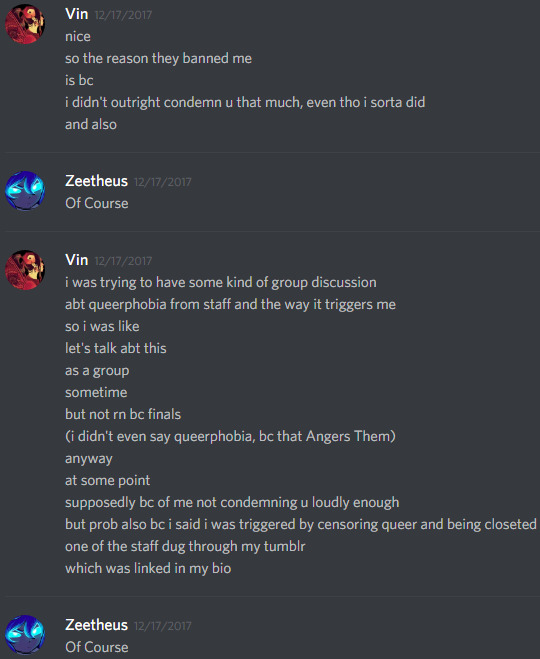

I wasn’t surprised at this point. Staff had made it plain and clear to me that if they had a mild enough reason to ban you, they’ll find whatever evidence they need in order to finalize it.

FOUR POSTS, YALL. FOUR POSTS AND SHE GOES FROM ‘ONE OF THE MOST ACTIVE AND BELOVED COMMUNITY MEMBERS’ TO ‘A BONA FIDE THREAT TO PEOPLE ON QUIXOL, WORTH BANNING.’
The four posts in question will be linked later, for now, continuing:

So... it’s not actually about protecting people on the server, it’s about... finding people that agree with your particular flavor of “LGBT+” politics?
R...really?
Where is the actual harm that Vin has done on the server to warrant being banned?
Shit, what about me? What tangible, material harm did my tweets, squirreled away on my own separate twitter, that no one follows me on, do to anyone on the server?
Anyways it doesn’t end here, because in this chain of bullshit, someone else went down trying to ask staff “why for the love of god did you ban Vin?”
Screenshots (Warning, it’s 65 pages long)
All four posts that Vin was banned over are included as well.
But if you’re interested in my personal highlight reel:
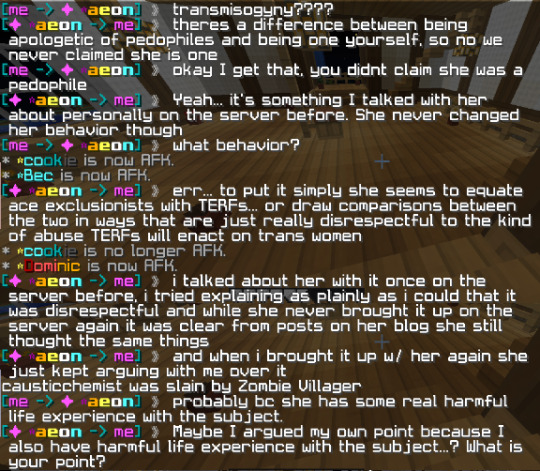
ah yes, a non-ace trans woman trying to silence anyone who casts doubt on her decisions to silence queer ace people for having experienced abuse similar to hers, because that’s not some top-tier oppression olympics ‘my pain outweighs yours’ b.s.

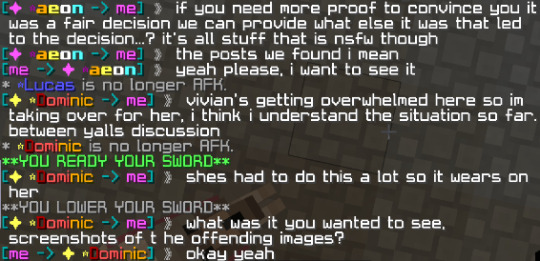
remember that time staff literally approached vin of their own volition with screenshots of my tweets at the ready, trying to grill vin about my tweets and whether or not she agreed with them?
where’d that go?
did they suddenly get tired of it after being confronted with other, perfectly average Quixol users, suddenly also questioning their decisions against their will?

funny how vin got to have a discussion about her posts. wonder why they didn’t ever contact me except to ban me


so one of the posts was barely incriminating, but the staff decided to use it against her AS A PSYCHOLOGICAL TEST, and then decided to use it decisively against her after she didn’t give the reaction they wanted from her (again, they mention it as one of the 4 posts she was banned over)

THIS WOULD BE PERFECTLY REASONABLE IF THEY HADN’T BEEN LITERALLY SEARCHING THROUGH HER TUMBLR, DIGGING UP POSTS FROM UP TO TWO YEARS AGO
IT WOULD ALSO BE REASONABLE IF:
I HAD ACTUALLY PUT MY TWITTER URL IN MY BIO, WHICH I’M PRETTY SURE I DID NOT
I HADN’T BEEN BANNED NOT TWO WEEKS AGO FOR EXISTING ADJACENT TO QUIXOL, BARELY IF EVER MENTIONING IT ON TWITTER, NEVER LINKING IT FROM THE SERVER, WHO THE HELL WAS SEARCHING THROUGH MY TWITTER, AND WHY DIDN’T BEAN EVEN MENTION DEFENDING MY RIGHT TO HAVE A SEPARATE TWITTER THAT WAS NOT PUBLICLY LINKED TO QUIXOL!? WHAT!?!
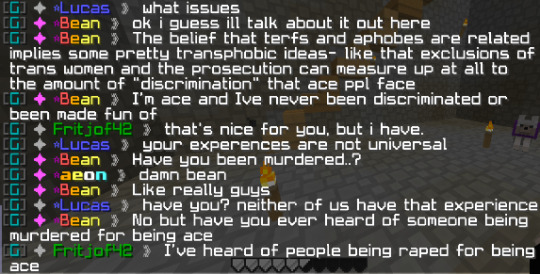
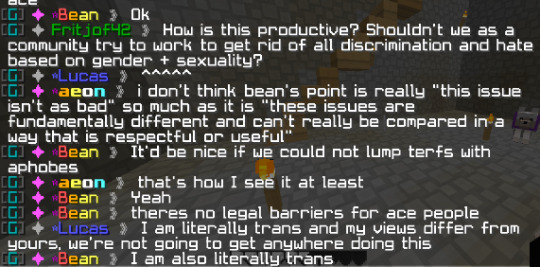
glad to know the rest of the staff also goes full tilt on oppression olympics

still waiting on the part where vin actually said something transmisogynistic or otherwise materially harmful to someone on the server

oh no!! vivian just called a lesbian trans woman transmisogynistic!! clearly if this is the game staff wants to play that means they all needs to either agree to disagree, or realize that peoples’ experiences differ from theirs, and are not something to be weaponized in order to silence people that you disagree with!! what a world!!
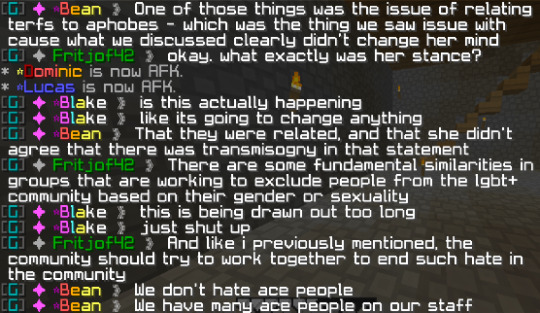
tfw staff tokenize themselves before they even make the slightest movement towards ‘people have different experiences besides the ones i have/know about, but we are all here and we should work together and support each other’
are they even really a real LGBT+ server
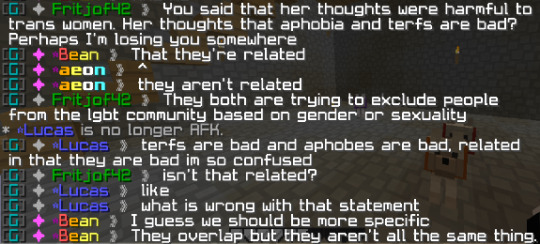
very clear, very clear distinction here... somewhere? weren’t they just saying that they’re not the same things? so they overlap but are different? uh... and...???

i don’t have a word for ‘white trans women that try to weaponize the transmisogyny that overwhelmingly nonwhite twoc experience in order to silence anyone who questions her ~*authority*~ despite the fact that there is no universal ‘trans woman experience’ that anyone can hold her as an authority AS’...
this is literally the kind of weaponized-suffering authoritarianism people talk about when they deconstruct neoliberalism and ‘oppression olympics’ and the staff all seem to be very involved in it
gee whiz, im no longer wondering why i, a queer aro ace, was banned
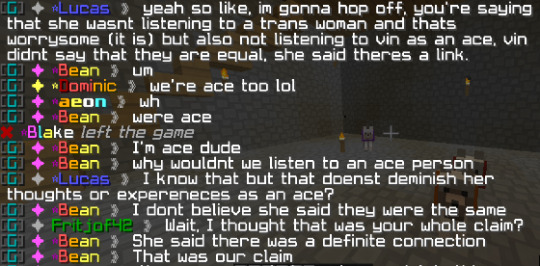
bean weaponizing his aceness as the staff’s ‘authority’ on ace matters, instead of, yanno, understanding that vin has had her own experiences, that are different, which leads her to take different stances
especially since bean himself admits he hasn’t faced any problems due to his aceness
lucky him, i guess
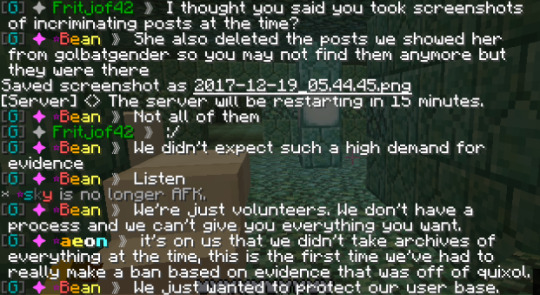
“this is the first time we’ve had to really make a ban based on evidence that was off quixol”
fuck you in particular
my tweets weren’t for you or anyone else on Quixol
you and the rest of the staff decided to ban me anyways
and now that you snatched vin in your chain-ban and you have a lot of people who are QUESTIONING YOUR DECISIONS you try and act sympathetic?
if people are reacting like this, and the evidence wasn’t even on the server, why even ban someone?
if you intend to heavily police Quixol users you should maybe fucking say so
that way no one’s suprised
i have intense paranoia issues and the entire fact that YALL WERE STALKING MY TWITTER hasn’t helped in the least
literally here are tweets i made in the same timeframe as my ~*banned tweets*~


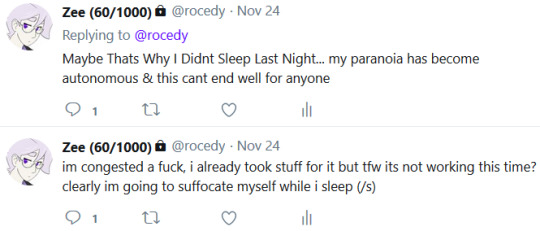
like you claim to be protecting users, despite the fact that no one on the server was harmed
and you claim to be inclusive, despite the fact that you silence queer people at every turn
and you claim to be safe for ND people, while causing them anxiety and paranoia
literally what do you even stand for at this point

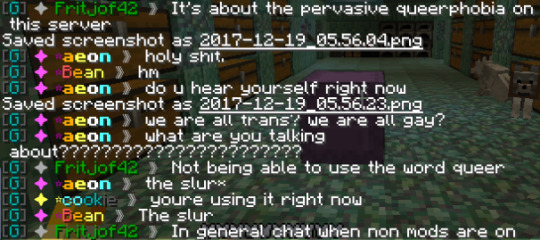
"we are all trans? we are all gay?”
yeah? and?
you still closet the hell out of queer people?
especially queer people with identities you don’t like?
queer people who literally use the word to describe their OCs in plural since they are neither gay nor trans?
you literally wouldn’t let me use the word ‘queer’ to describe my OCs?
hhhhhhhhhhhhh

oh no!!! queer people exist online
seriously is this an LGBT+ server or some kind of fundie christian camp
also, get a load of all of the 0 times vin and i have called anyone queer without their consent, seeing as the first and only time I used it, i got scolded by staff for it

funny story. as soon as I read this screen i knew why I was actually, really banned
way back up at the top of this post, when i had confronted Blake about the fact that I had just called my OCs ‘queer’
and was told ‘be careful, don’t use that word on people who don’t want it applied to them’
i had already been mislabeled as ‘gay’ numerous times on the server itself, which was triggering for me
after bringing up that particular grievance with staff, using almost the exact same wording as Fritjof, i decided to blacklist ‘gay’ so that i wouldn’t guilt gay people into hiding it from others, while protecting myself
very interesting that the staff doesn’t have the same attitude towards people being able to protect themselves from ‘queer’
it’s almost like the censoring of queer is not for the sake of protecting users... but instead...

Just so we make this clear, ‘queer’ which staff defines as being ‘gay and trans’ (but not queer itself for some reason?) is equivalent to:
triggering thing that must be blacklisted (that’s why the blacklist exists)
nsfw chats in global
literally how do yall say ‘queer means gay and trans’ and equate its use with ‘nsfw’
again... is this an LGBT+ server... or a conservative christian summer camp...

it feels almost... indistinguishable...
yes, that is the admin of an ND & LGBT+ server using the same ‘real world’ rhetoric that anti sj bigots and conservatives make
interestingly enough, it’s also common among bigots in the LGBT community, such as truscum, aphobes, and queerphobes, towards anyone with a ‘special snowflake’ identity that they don’t particularly like or are interested in including
but an ace man can never be acephobic right? he’s an authority on ace issues after all, and so all aces must have his same experiences
/s


pedophilia?? gee whiz i wonder what that post Vin reblogged about ‘people accusing others of pedophilia that weren’t actually pedophilia’ was about. surely it wasn’t about staff, right?
so, recap of bannable offenses here on Quixol Dot Corn:
Have a public twitter, where you tweet opinions that staff disagrees with
Be friends with the above person who was banned, and when you don’t say anything banworthy when they confront you, have a tumblr account with enough questionable posts for them to construct a banworthy offense
Once both of the above have been banned, ask staff about their decisions, and then try to reasonably discuss their ongoing queerphobia
So anyways, if you’re wondering where Zeetheus, Vin_Venture, and Fritjof42 went... that’s pretty much what happened!
Staff has zero intent on protecting their userbase, just policing the hell out of their opinions, to the point where off-Quixol content is considered a bannable offense, and if staff hasn’t made that clear to anyone, I hope this post does.
Queer people are not safe on Quixol
Unacceptably ace people are not safe on Quixol
The vast majority of people under the LGBT+ umbrella that don’t fit under ‘gay and trans’ are not safe on Quixol
People with anxiety, who have experienced stalking paranoia are not safe on Quixol
0 notes